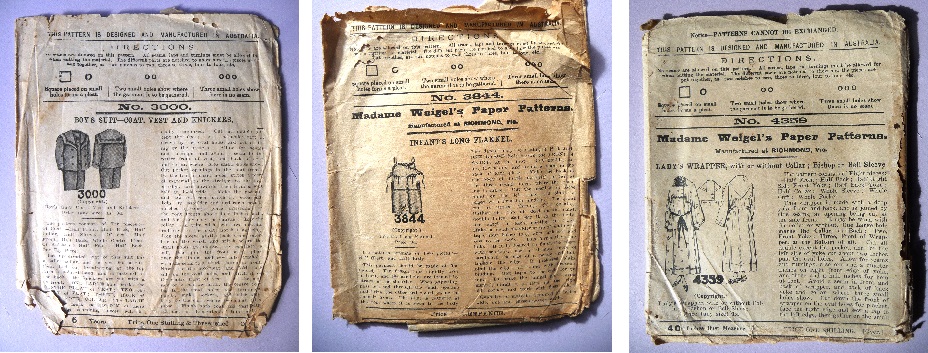My story so far
16 May 2015 11:50 AMVeronica LampkinMY YEARS WITH MADAME WEIGEL
With Madame Weigel: the Woman who Clothed the Australasian Colonies only just on the market, a few words to describe my journey so far.
At a collectables fair in 2006 I found 22 of Madame Weigel’s old patterns, and very quietly snapped them up at $1 each. Of course the patterns were not dated, but I knew they were early C20th because of the styles illustrated.
I also knew who Madame Weigel was, but little of her background. I was most intrigued by Madame’s paper patterns, but I also knew of Weigel’s Journal of Fashion, and Madame Weigel’s craft patterns from the 1930s such as Cushions & Cosies, Prize-Winners, and Sixteen Lovely Bed-Jackets and Capes.
Having always been interested in sewing and history, I kept wondering how to date my patterns. Would Madame Weigel’s journal hold the key? I saw that the State Library of Victoria held an almost full set of Madame’s journal from 1884 to 1950 (the first four years were missing, and some other editions), and tentatively bought one roll of microfilm of Weigel’s Journal of Fashion. Using a microfiche reader in a local library, I soon realised that Weigel’s Journal of Fashion had been used to market Madame Weigel’s pattern series; that the series stretched for well over 70 years; and that this was a remarkable record of not only the history of fashion and clothing in Australasia, but what women were sewing to support domestic life.
However – and this was a big however - a total of 22 rolls of microfilm held the extant history of Weigel’s Journal of Fashion, known as Madame Weigel’s Journal of Fashion from September 1915 onwards. I knew this would be a massive volume to tackle, and would require prolonged use of a difficult medium: few people love working with microfilm.
To commit, or not to commit, was the quandry. The answer soon came as I decided to study Madame Weigel’s work by PhD and enrolled at Queensland College of Art, Griffith University, a place I knew well and one that would enable Madame Weigel's images to stay strong. The woman who was Madame Weigel was now firmly a part of my life, and has remained so for the past eight years.
I took six years to complete my PhD as a part-time student, although the commitment was more like a full-time job. Under the excellent guidance of Dr Craig Douglas and Associate Professor Bonnie English (now sadly no longer with us), my thesis took shape and in September 2013, under the title “Mining the Archive: an historical study of Madame Weigel’s paper patterns and their relationship to the fashion and clothing needs of colonial Australasia during the period 1877 to 1910”, I graduated with Academic Excellence (a thesis unchanged by the examiners).
My particular interest was in Madame Weigel’s paper pattern series, a series that offered more than 9000 new patterns over nine decades, and countless repeated patterns of those that remained in demand. Also of note is Madame Weigel’s geography – her influence spread across all Australasian colonies, her loyal band of supporters often with her for life, and through generations as Madame’s patterns clothed from birth through to mourning. Madame Weigel was particularly important in rural life, enabling women to economically clothe their families through her sensible patterns for everyday life: some enduring patterns remained valid for three decades.
Those who have survived doctoral study will know the feeling of relief at the end, and some leave the study just there, where it finished, relieved to walk away. For me, Madame Weigel persisted: it seemed wrong, having harvested so much, to walk away, and for what I had discovered to just disappear back into the archive. A key factor was the sheer volume of material I now had – should I just discard this? Another was the rewarding journey to get this far - I had loved the study and the learning. Could I do more?
I decided to commit again to push my work further and publish as much of what I knew as possible. This meant that I could begin to place my findings on the public record – and in a more user-friendly way than through a doctoral thesis. By privately publishing my findings, I can now continue to create works on different aspects of Madame Weigel’s history, particularly her paper pattern series, my main focus of interest.
I hope this allows Madame Weigel to have a better place in Australasian history than she has, to date, been accorded. This first work, a biography, is intended to introduce Madame Weigel and the remarkable woman that she was, before proceeding to write more about her publications and business practices.
© Dr Veronica R. Lampkin: Madame Weigel’s Patterns. 16 May 2015.
Some of the oldest patterns found

